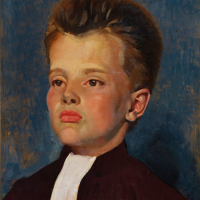7. GEORGE W. LAMBERT

The death of George Lambert in 1930 marked the end of the extraordinary life of a painter who in passing called neither Australia nor England home. Restlessness and energy marked Lamberts life, and in death the tributes flowed from painters who saw Lambert as the great light of Australian painting and one of the last Edwardians. Publicly, the response was swift with the mounting of the Lambert Memorial Exhibition in Sydney in November soon after the artists death.
It is from this exhibition that The Blue-Coat Boy 1918 comes. It is a portrait that relates to Constant Lambert as a Blue-Coat Boy 1916, a painting exhibited in the George Lambert Retrospective at the National Gallery of Australia in 2007. Both paintings show Constant in his Christs Hospital school uniform, both in three quarter. In this, our present lot, the young Constant, already thirteen, sits with head raised and gaze fixed. He seems already to have addressed the greater and more pressing issues of his future role as a composer and musical critic.
George Lambert was by all accounts a distant father to Constant and his first son Maurice, but absence, allied to the artistic example his father set, provided Constant with the means to set his own course and to better his beginnings which he described fancifully as A Francophil [sic] English composer-conductor born to an Australian painter from St Petersburg.1
Constant had great early acclaim working famously with Serge Diaghilev on the commissioned ballet Romeo and Juliet in 1926. As Musical Director of the Vic-Wells ballet and in turn Sadlers Wells ballet from the early thirties gave Constant huge influence and the platform from which to write and produce music, notably Horoscope 1938 and Tiresias 1951.
To view George Lamberts portrait The Blue-Coat Boy is to look back on an extraordinary life. The sitters achievements are clearly noted but it is what the painter brings to the present moment that is telling. Constant is contained most beautifully by a network of visual inflections: the upright proud-pose and the red-rouge lips - one practical, the other sensuous, signpost engagement. The shallow depth of the portrait brings close attention to the head, hair and skin. The red-apple cheeks belie the intent that life holds for the sitter. From without, the painter, pater familias, applies paint quickly, confidently.
How fortunate then to see this painting again in the public domain having been held in the same family for more than 75 years. The Blue-Coat Boy speaks equally of the artist George Lambert as it does of the sitter, Constant. They remain, father and son, a testament to artistic will and lives lived passionately.
Footnotes:
1. Motion, A., The Lamberts: George, Constant and Kit, The Hogarth Press, London, 1987, p.121
Brett Ballard